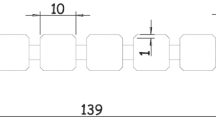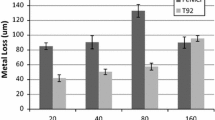Abstract
Corrosion of inbed components in coalburning fluidized bed combustors (fbc) is a potential matter of concern. Two types of corrosion problems were identified in early studies: sulfidation/oxidation of more highly alloyed materials at metal temperatures above 600 °C; and accelerated oxidation, not usually apparently involving sulfidation, of lowalloy steels at lower temperatures. It is generally accepted that the major factors in the corrosion are the presence of calcium sulfate in the bed and the existence of transient low oxygen partial pressures; without either one of these, the corrosion is minimal. In this paper, the general characteristics of an fbc will be described and the two different types of corrosion will be briefly reviewed. Finally, materials selections, design criteria, and operational procedures to minimize the corrosion will be discussed.
Similar content being viewed by others
References
Curtiss-Wright Corporation, “Engineer, Design, Construct, Test and Evaluate a Pressurized Fluidized Bed Pilot Plant Using High Sulfur Coal for Production of Electrical Power”, U.S. DOE Contract No. EX-76-C-01-1726.
R. L. McCarron and R. P. Brobst: “Gas Turbine Blade Materials’ Corrosion in the Effluent from a Pressurized Fluidized Bed Combustor”, ASME Paper No. 84-GT-208. See also Quarterly Report No. DOE/ ET/15457-1112, January-March 1982, prepared for U.S. DOE under Contract No. DE-AC21-79ET15457.
R.L. McCarron: work in progress on EPRI Research Project RP1337-1.
R. L. McCarron: work in progress under EPRI Research Project RP 979-12. See also NCB (IEA Grimethorpe) Ltd., “Turbine Blade Test Cascade Modifications and Operation, August 1982 to April 1983”, Report No. GEF/R/83/12, March 1984.
National Coal Board Report to the Environmental Protection Agency, “Reduction of Atmospheric Pollution”, Report Number DHB 060971, 1971.
National Coal Board Coal Research Establishment, “Materials Problems in Fluidized Bed Combustion Systems”, Final Report to the Electric Power Research Project RP388, Report No. CS-1449, May 1980.
J. Stringer and A. J. Minchener: “The Effect of Overall In-Bed Oxygen Concentration on Corrosion in Fluidized Bed Combustors”, inProc. 7th Intl. Conf. on Fluidized Bed Combustion; U.S. Department of Energy DOE/METC/83-48, Washington, DC, 1983, pp. 1010–19.
J. Stringer and S. Ehrlich: “High-Temperature Corrosion in Fluidized Bed Combustors”, ASME Paper 76-WA/CD-4, December 1976.
M.J. Cooke, A.J.B. Cutler, and E. Raask:J. Inst. Fuel, 1972, vol. 45, p. 153.
D.P. Saari and R.J. Davini: “Evaluation of Instruments for In-Bed Oxygen Measurements in a Fluidized Bed Combustor”,Proc. 7th International Conference on Fluidized Bed Combustion, U.S. DOE/ METC/83-48, 1983, p. 995.
J. Stringer: “High Temperature Corrosion in Mixed Gaseous Oxidants”, in “Metals and Energy”,Proc. 33rd Ann. Conf. of the Australasian Inst. of Metals, University of Auckland, Auckland, New Zealand, 1980, pp. 143–46.
See, for example, H. H. Krause and V. Nagarajan: “Corrosion of High-Chromium Alloys in AFBC Boilers”, Final Report on TVA Contract No. TV-36914A, March 12, 1984; and H.C. Akuezue: “Calcium Sulfate Induced Accelerated Corrosion”, M.S. Thesis, Lawrence Berkeley Laboratory of the University of California, Berkeley, CA, Report No. LBL-10286, December 1979.
S.R. J. Saunders, M.K. Hossain, B. Kent, and D.M. Lloyd: “The Sulfidation of Alloys Used in a Fluidized Bed Combustor”,High Temp. Tech., 1984, vol. 2, p. 63.
I. G. Wright, M. A. Rocazella, and J. Campbell: “Characterization and Comparison of the Corrosive Environment in Battelle’s 0.28 m2 and Rocketdyne’s 3.24 m2 Fluidized-Bed Coal Combustors”, Paper No. 91 in the National Association of Corrosion Engineers Annual Meeting, Corrosion/84, April 1984.
A. J. Minchener, E. A. Rogers, and R. D. LaNauze: “Materials Problems in Fluidized Bed Combustion Systems”, Interim Report to EPRI on Research Project RP979-1, Report No. CS-1475, August 1980.
A. J. Minchener, P. T. Sutcliffe, D. C. Read, T. J. Golesworthy, D. M. Lloyd, I. S. Scott, R. S. Courtney, and R. G. Holder: “Materials Problems in Fluidized Bed Combustion Systems”, Final Report to EPRI on Research Project RP979-1, Report No. CS-1853, May 1983.
A.J. Minchener, P.T. Sutcliffe, I.S. Scott, R. S. Courtney, D.M. Lloyd, D. C. Read, T. J. Golesworthy, and J. E. Oakey: “Materials Evaluation for Fluidized Bed Combustion Systems”, Final Report to EPRI on Research Project RP979-11, Report No. CS-3511, August 1984.
A.J. Minchener, D.M. Lloyd, P.T. Sutcliffe, D.C. Read, J.E. Oakey, and R.S. Courtney: work in progress on EPRI Research Project RP979-11.
A. G. Roberts, R. V. Wardell, and A. J. Minchener: “In-Bed Corrosion Tests of Superheater Alloys in a 10-Square-Foot AFBC”, Final Report to EPRI on Research Project RP979-2, Report No. CS-2118, November 1981.
Work performed by Babcock and Wilcox under EPRI Research Project RP718-2.
P. L. Daniel: “Examination of the Original In-Bed Tube Bundle from the EPRI/B & W 6′ x 6′ AFBC Boiler After 300 Hours of Operation”, Babcock and Wilcox Internal Report, File No. LR:80:4775-03:01, September 26, 1980.
R. H. Cooper and J. H. DeVan: “Preliminary Report on Corrosion Analysis of Heat Exchanger Tubes from a Fluidized-Bed Combustor, in “Ash Deposits and Corrosion Due to Impurities in Combustion Gases”, R. W. Bryers, ed., Hemisphere Publishing Corp., Washington, DC, 1977, p. 561.
T. G. Godfrey and J. H. DeVan: “Corrosion of High Temperature Materials in AFBC Environments, Part 2 (4500 h Tests)”, Oak Ridge National Laboratory Report ORNL/TM-7734/P2, August 1981.
A. M. Hall, D. A. Vaughan, H. H. Krause, Jr., H. E. Carlton, G. H. Stickford, Jr., A.A. Boiarski, and R.G. Luce: “Evaluation of Heat Exchanger Materials for Use in Coal-Fired Fluidized Bed Combustion Environment”, Battelle Columbus Laboratories, FE-2325-19, 1978.
M. A. Rocazella and I. G. Wright: “The Corrosion Behavior of Some Candidate Heat-Exchanger Alloys in the AFBC Environment”, in “High Temperature Materials Problems in Coal Combustion and Utilization”, I.G. Wright, ed., Electrochemical Society, Pennington, NJ, 1983.
The Rocketdyne results are described in Ref. 25.
I.G. Wright and A.J. Minchener: “Materials Selection for Metallic Heat Exchangers in Advanced Coal-Fired Heaters”, ASME Paper 82-GT-226; also inJ. Eng. for Power, 1983, vol. 105, pp. 446-54.
N. Andrews: Nova Scotia Power Corporation, personal communication.
V. K. Sethi: Report to TVA on the performance of materials in the 20MW AFBC at Padukah, KY, 1984. Preliminary information is contained in “Campaign II Interim Report”, Technical Summary, April 7-Sept. 17, 1983 prepared by the Tennessee Valley Authority Division of Energy Demonstrations and Technology for EPRI, December 1983.
P. Ganesan, A. Sagues, and V. Sethi: “Mechanical Properties and Corrosion Behavior of Materials Exposed to an Experimental Atmospheric Fluidized-Bed Combustor”,J. Mat, for Energy Systems, 1984, vol. 6, pp. 38–49.
National Coal Board Coal Utilization Research Laboratory, “Fluidized Bed Combustion: 1000-hour Test Program in a Pressurized Fluidized Bed Combustion Facility”, Final Report No. FE-3121-15, prepared for the U.S. DOE under Contract ET-78-C-01-3121.
G.J. Lane, P.T. Hilliard, G.S. Blackaller, C.B. Tydd, and A.J. Caims: “Studies of In-Bed Corrosion in a Pressurized Fluidized-Bed Combustor”, Final Report to EPRI on Research Project RP979-3, Report No. CS-1935, July 1981.
J. Mogul, S. Moskowitz, and S. M. Wolosin: “Materials for Pressurized Fluidized Bed Air Heater System”,Proc. 6th Intl. Conf. on Fluidized Bed Combustion, U.S. Department of Energy, Conf-800428, Washington, DC, 1980, pp. 482–95.
The International Energy Agency Grimethorpe PFBC Project is sponsored by three countries: the U.S.A., the U.K., and the D.F.R. The reports from the project are distributed in the U.S.A. by the Department of Energy under International Agreement ET 10393.
NCB (IEA Grimethorpe) Ltd., “Materials-Related Problems and Investigations During Test Series 1”, IEAG Report No. GEF/R/83/16. July 1984.
A. J. Minchener, D.M. Lloyd, and J. Stringer: “The Effect of Process Variables on High Temperature Corrosion in Coal-Fired Fluidized-Bed Combustors”, inCorrosion Resistant Materials for Coal Conversion Systems, D. B. Meadowcroft and M. I. Manning, eds., Applied Science Publishers, London, 1983, pp. 299–322.
J. H. De Van and P. J. Ficalora: “Investigations of Gas-Metal Reactions in Cyclic Oxidizing and Reducing Atmospheres and the Effect of Sulfate Deposits on Corrosion”, in the Quarterly Progress Report for the period ending 9/30/1983 on the U.S. Department of Energy Fossil Energy AR & TD Fossil Energy Materials Program Report No. ORNL/FMP-83/4, p. 441.
J. Stringer and D. P. Whittle: “High Temperature Corrosion of Metals and Alloys in Fluidized Bed Combustor Environments”, Proc. VGB Intl. Conf. on Corrosion and Deposition in Power Plants, Essen, 1977.
K. Mark, J. Stringer, J.S. Lin, and D. A. Stevenson: “Oxidation-Sulfidation Corrosion in Fluidized Bed Combustor Environments”, inHigh Temperature Materials Chemistry-II, Z. A. Munar and D. D. Cubicciotti, eds., The Electrochemical Society, Pennington, NJ, 1983, p. 360.
K. Natesan: work in progress at Argonne National Laboratories.
A.J. Minchener and J. Stringer: “Development of a Technique for Measuring Oxygen Partial Pressures Within a Fluidized Bed”, inCorrosion-Erosion-Wear of Materials in Emerging Fossil Energy Systems, A. V. Levy, ed., National Association of Corrosion Engineers, Houston, TX, 1982, p. 832; A. J. Minchener and J. Stringer: “The Use of Electrochemical Probes for Measuring Oxygen Partial Pressures Within a Fluidized Bed”,J. Inst. Energy, 1984, vol. 57, p. 240.
Author information
Authors and Affiliations
Additional information
Currently on leave at Lawrence Berkeley Laboratory, University of California, Berkeley, CA, 94720.
Rights and permissions
About this article
Cite this article
Stringer, J., Minchener, A.J. High temperature corrosion in fluidized bed combustion systems. JMES 7, 333–344 (1986). https://doi.org/10.1007/BF02833572
Issue Date:
DOI: https://doi.org/10.1007/BF02833572




